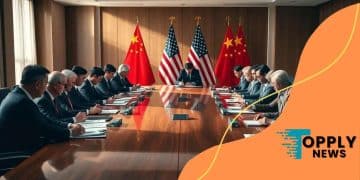US-China trade war 2025: What does the future hold?

The US-China trade war influences global markets and consumer prices, requiring businesses to adapt by diversifying suppliers, investing in technology, and staying informed about changing trade policies.
The US-China trade war 2025 is likely to influence more than just tariffs; it might reshape global economic dynamics. Have you considered how these changes could affect your daily life and the global marketplace? Let’s dive into the unfolding narrative.
Understanding the origins of the US-China trade war
The US-China trade war has its roots in historical tensions and economic competition. Understanding its origins can help clarify why this conflict emerged and the implications it has for global trade.
One significant factor is the balance of trade. For years, the United States has faced a substantial trade deficit with China. Many argue that this has prompted the U.S. to adopt more aggressive trade policies1.
Key factors contributing to the trade war
Several other factors played crucial roles in the escalation of the trade war:
- Intellectual property theft allegations
- Technological competition, especially in sectors like telecom
- China’s subsidies for local industries
- U.S. concerns about national security
The political climate also affected these events. In recent years, the U.S. government raised concerns regarding China’s growing influence on the world stage. Tariffs were implemented in response to perceived unfair practices. These actions aimed to protect American jobs and industries.
On the other hand, China responded with its own tariffs, leading to a cycle of retaliation that intensified the trade conflict. This back-and-forth not only impacted businesses but also consumers, as prices began to rise due to the increased costs of imported goods.
The role of global markets
The US-China trade war is not only a bilateral issue but also affects global markets. Many countries rely on trade with both nations, and disruptions can have widespread consequences. Supply chains have been reshaped as companies seek to mitigate risks associated with tariffs, leading to a shift in manufacturing locations.
Understanding the origins of the US-China trade war helps frame the ongoing discussions about trade policy. As both powers navigate this complex landscape, the future of global commerce remains uncertain, requiring constant adaptation from governments and businesses alike.
Key economic impacts of the trade dispute
The economic impacts of the US-China trade dispute are significant and far-reaching. As tariffs increased, businesses on both sides of the Pacific faced new challenges. These changes affect not only large corporations but also small businesses and consumers.
One major impact is the increase in prices for goods. Tariffs on imports lead to higher production costs, which are often passed on to consumers. This means everyday items like electronics, clothing, and even food could become more expensive.
Effects on global supply chains
The disruption of global supply chains is another key economic consequence. Many companies rely on parts manufactured in China. With tariffs and uncertainty, some firms may choose to relocate production to other countries. This shift not only changes where products are made, but it can also increase costs.
- Manufacturers may face delays in producing goods
- Shifts in production can lead to job losses
- New suppliers may not meet quality standards
- Companies may need to invest in new facilities
Another important factor is the effect on economic growth. The trade dispute can slow down economic expansion as businesses become more cautious. They may hold off on investments or hiring due to uncertainty. As a result, this could lead to stagnation in both the US and Chinese economies.
Job market ramifications
The trade war also affects employment. Some sectors, such as agriculture, suffer tremendously. Farmers in the US have lost access to critical markets as China imposed tariffs on American goods. Many have had to rethink their strategies and look for alternative options.
In contrast, some industries might benefit, particularly those in manufacturing and technology sectors. For example, increased demand for certain products could lead to job creation in these areas. Despite this, the overall impact on the job market can be mixed and challenging.
Having a deeper understanding of the key economic impacts of the trade dispute paints a clearer picture of what’s at stake for global economies. As the situation evolves, both consumers and businesses will need to adapt continuously to these changes, making informed decisions about their economic futures.
How tariffs are reshaping consumer prices

Tariffs set by governments can have a notable impact on consumer prices. When tariffs increase on imported goods, companies often pass these costs onto consumers. This means that common items we buy every day can suddenly become more expensive.
Many people notice this increase when shopping for electronics, clothing, or even household goods. For instance, if tariffs rise on technology products manufactured in China, consumers might see higher prices at their local stores. Understanding how tariffs work is essential to grasp their effects on our wallets.
Direct impacts of tariffs on goods
Several factors contribute to changing prices as a result of tariffs:
- Higher production costs for manufacturers
- Reduced competition among suppliers
- Increased prices for imported raw materials
- Negatively affected domestic industries
When tariffs are applied, businesses face increased costs. To maintain their profit margins, they often raise prices. For example, if a company imports shoes from China and faces higher tariffs, the company may increase the price of those shoes in retail stores. This affects how much consumers pay for the same products.
Influence on consumer behavior
The imposition of tariffs can change how consumers behave in the market. When familiar products become too expensive, shoppers might look for alternatives. This could mean choosing lower-cost options or supporting local brands instead of imported ones. Some consumers may even delay purchases, hoping that prices will drop again.
At the same time, the perception of price increases can lead to broader economic consequences. If many consumers feel the pinch from rising prices, it can slow down overall spending. This slowdown can ripple across the economy and impact various sectors, leading to reduced growth. Thus, understanding how tariffs are reshaping consumer prices is crucial for everyone.
Future predictions for US-China trade relations
The future predictions for US-China trade relations are uncertain but crucial for global economies. As both nations navigate their complex relationship, various factors can significantly influence outcomes.
Experts suggest that geopolitical tensions will continue to shape trade policies. As both the US and China try to assert their influence, tariffs and trade barriers may remain in place for the foreseeable future.
Potential scenarios for trade relations
Several scenarios could unfold in the coming years:
- Increased cooperation: Both countries may find common ground to address global challenges, leading to reduced tariffs and improved trade.
- Continued conflict: Tensions may escalate, resulting in further sanctions and trade restrictions that could hinder economic growth.
- Decoupling of economies: Industries might become more isolated from each other, leading to a significant restructuring of global supply chains.
As businesses on both sides prepare for these possible outcomes, they must remain agile and adaptable. The environment is highly unpredictable, and companies will need to make strategic decisions based on evolving circumstances.
Impact on global markets
The international community is also watching closely. Nations that trade heavily with both the US and China may find themselves caught in the middle. The future of US-China trade relations will likely affect tariffs, prices, and ultimately economic stability across the globe.
Furthermore, the decisions made by either nation can trigger a ripple effect, impacting smaller economies that depend on trade routes and agreements. This dynamic will keep businesses on their toes as they adapt to shifting trade landscapes.
In this landscape of uncertainty, stakeholders must continuously monitor developments and innovate to remain competitive. Understanding these trends will be vital for informed strategic planning in the years to come.
Strategies for businesses to navigate the trade landscape
Businesses need to develop strategies to navigate the current trade landscape shaped by the US-China trade war. The ongoing tensions mean that adapting to changes quickly is essential for success.
Focusing on flexibility is vital for companies. This means being prepared to adjust supply chains and operational practices without significant delays. Understanding the market dynamics will help businesses make informed decisions that can protect their interests.
Key strategies for adapting
Several effective strategies can help businesses thrive in this complex environment:
- Diversify suppliers: Relying on a single country for products can be risky. By using multiple suppliers from different regions, companies can reduce risk.
- Invest in technology: Automation and supply chain software can improve efficiency. Companies that use technology effectively can lower costs and enhance productivity.
- Monitor regulatory changes: Staying updated on trade policies is crucial. Being aware of upcoming tariffs or changes in regulations can help businesses take proactive measures.
- Engage in local sourcing: Whenever possible, sourcing materials locally can minimize risks associated with international trade disputes.
In addition to these strategies, effective communication is key. Keeping teams informed about market trends and changes in trade policies can lead to better decision-making. Encouraging collaboration within the organization can foster innovative solutions to emerging challenges.
There is also value in forming strategic partnerships. Collaborating with other companies can create opportunities for joint ventures and shared resources. This can enhance competitive advantage and foster resilience in times of uncertainty.
Proactive monitoring and adaptation
A business that continuously monitors the trade environment can make better decisions. Implementing feedback loops to understand customer preferences can also provide insights that help shape product offerings. This adaptability can be crucial in rapidly changing conditions.
Ultimately, businesses that embrace flexibility, invest in technology, and remain informed are better positioned to navigate the trade landscape. Being prepared for shifts in the market will ensure that they can respond effectively and sustain growth.
In conclusion, the landscape of US-China trade relations is complex and evolving. Businesses must stay informed and adaptable to navigate this changing environment effectively. By implementing strategic measures, such as diversifying suppliers and investing in technology, companies can position themselves for success. Understanding the economic impacts of tariffs and being proactive in monitoring trade policies will also be essential. Ultimately, those who remain flexible and proactive can better manage the challenges and seize new opportunities in the global market.
FAQ – Frequently Asked Questions about US-China Trade Relations
What are tariffs and how do they affect businesses?
Tariffs are taxes on imported goods. They increase costs for businesses that rely on imported products, often leading to higher prices for consumers.
How can businesses prepare for changes in trade policies?
Businesses should stay informed about trade news, diversify suppliers, and invest in technology to adapt quickly to new regulations.
What strategies can companies use to mitigate risks associated with trade disputes?
Companies can diversify their supply chains, engage in local sourcing, and foster partnerships for shared resources to lower risks.
How do trade relations impact consumers?
Trade relations can affect consumer prices, product availability, and the overall economy, as tariffs can lead to increased costs for goods and services.





